Delay-Aware Online Service Scheduling in High-Speed Railway Communication Systems
Abstract
We investigate the downlink service scheduling problem in relay-assisted high-speed railway (HSR) communication systems, taking into account stochastic packet arrivals and quality-of-service (QoS) requirements. The scheduling problem is formulated as an infinite-horizon average cost constrained Markov decision process (MDP), where the scheduling actions depend on the channel state information (CSI) and the queue state information (QSI). Our objective is to find a policy that minimizes the average end-to-end delay through scheduling actions under the service delivery ratio constraints. To address the challenge of centralized control and high complexity of traditional MDP approaches, we propose a distributed online scheduling algorithm based on approximate MDP and stochastic learning, where the scheduling policy is a function of the local CSI and QSI only. Numerical experiments are carried out to show the performance of the proposed algorithm.
1. Introduction
Recently, high-speed railway (HSR) systems have developed rapidly all over the world. The passengers on the train will not only enjoy the short journey but also have a high demand on multimedia services. The cellular network deployed along the rail lines can provide seamless coverage and data packets delivery. However, the data transmission rate is strictly limited due to the penetration loss in traditional HSR communication systems. As an alternative solution, the relay-assisted HSR network architecture has been proposed in [1, 2], which was considered a better choice than direct transmission in case of large penetration loss [3] and becomes a promising architecture for future broadband mobile communications in providing high data-rate services [4].
We consider a relay-assisted two-hop HSR network architecture in this work. The data packets are delivered via a relay station (RS) instead of direct transmission to achieve a high data transmission rate. The passengers send service requests when the train is moving. If a large number of services are requested, the resource contention among multiple services should be resolved and an efficient scheduling scheme should be proposed, which not only considers the highly dynamic channel due to the extremely high moving speed but can also be implemented in a distributed manner with low complexity. In addition, the buffering at network devices, for example, content server and RS, is involved; it is thus important to consider not only the throughput performance but also the end-to-end (e2e) delay performance. Delay is a key quality-of-service (QoS) criterion for real-time multimedia services. As a result, we will focus on the delay issues for multimedia services and aim at developing a delay-aware scheduling algorithm for the relay-assisted HSR communication systems.
Many of the previous studies have been conducted to improve performance on scheduling and resource allocation in HSR communication systems. In order to support the e2e real-time data application, [5] studied a circuit domain latency model and employed a priority scheduling algorithm to estimate approximate service latency. In HSR networks with a cell array architecture, [6] proposed a scheduling and resource allocation mechanism to maximize the service rate by considering the channel variations and handover information. The optimal resource allocation problem in a cellular/infostation integrated HSR network has been investigated in [7], considering the intermittent network connectivity and multiservice demands. However, to the best of our knowledge, none of them has addressed the delay-aware scheduling in downlink relay-assisted HSR communication systems. Although the two-hop HSR network architecture is simple, how to schedule multiple services for such a network when taking account of stochastic packet arrivals and QoS requirements is still an open problem. This motivates us to investigate the delay-aware downlink scheduling problem for relay-assisted HSR communication systems.
The contributions of this paper are threefold. First, the two-hop scheduling problem is formulated as an infinite-horizon average cost constrained Markov decision process (CMDP) with the objective to minimize the average e2e delay under the service delivery ratio constraints. The above CMDP problem is converted into an unconstrained MDP by Lagrange theory and then the general solution of the CMDP problem is given by traditional iterative methods. Second, since the general solution could not give a simple implementable solution due to the curse of dimensionality, in order to simplify the solution and address the challenge of centralized control, we propose a distributed online scheduling algorithm based on approximate MDP and stochastic learning. A linear combination of per-node value functions is employed to approximate the value function of the associated optimality equation. Based on the per-node value functions, a distributed two-stage scheduling policy is derived, which is a function of the local state information only. Third, simulation results show that the proposed algorithm can achieve better performance in terms of e2e delay and service delivery ratio compared to conventional schemes. Moreover, the convergence of the proposed scheduling algorithm is established through simulations.
The remainder of the paper is organized as follows. Section 2 provides the details of the system model and assumptions. Section 3 presents the CMDP problem formulation and discusses the general solution. In Section 4, we propose a distributed online scheduling algorithm using approximate MDP and stochastic learning. Section 5 shows the performance evaluation results obtained through simulations. Finally, Section 6 makes some conclusions.
Notations. In this paper, |𝒜| is the cardinality of set 𝒜. 𝔼[·] denotes expectation. Pr[·] is the probability measure. I[·] is an indicator function. ⌊x⌋ = max{n ∈ ℤ∣n ≤ x} and [x] + = max{x, 0}.
2. System Model and Assumptions
A relay-assisted HSR network architecture is shown in Figure 1. The cellular network deployed along the rail line can provide seamless coverage and data packets delivery. The base stations (BSs) are connected to the backbone network via wireline links. For simplicity, we assume that the bandwidth of the links from the backbone network to the BSs is sufficiently large so that the packets can be transmitted to BSs with a negligible delay. An RS with powerful antennas is installed on the top of the train to communicate with BSs. The RS is further connected to an access point (AP) which can be accessed by the users based on wireless local area network (WLAN) technologies. Thus, the two-hop wireless link consists of the BS-RS link and the AP-users link. With this two-hop architecture, radio signals do not need to penetrate into the carriages, and thus the radio signal penetration loss problem is resolved.
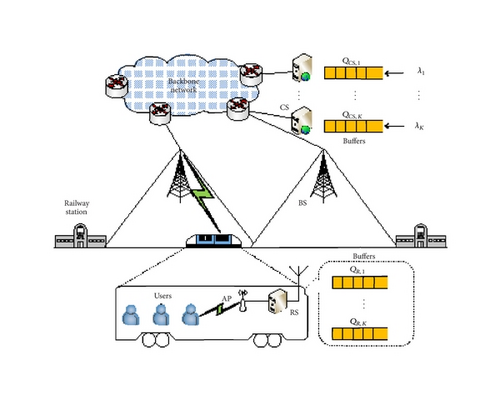
Distributed content servers are deployed in order to offload data traffic from the backbone network [8]. When a service is requested from the passengers, the data packets can be fetched from the corresponding content server (CS). To make the analysis of such network tractable, we assume each CS can provide one type of service. Notice that this can be easily extended to the situation where each CS can provide multiple types of services while one buffer is allocated to each type of service in the CS, which will be clear later on in Section 2.2. In order to simplify the protocol design for HSR applications, erasure coding based service delivery is considered [7] and the advantage is that no retransmission scheme is required for the transmission error due to a highly dynamic wireless channel condition.
Compared to the traditional cellular networks, the deterministic train trajectory in HSR networks is a unique feature [7, 9]. The train trajectory represents the location of a train at a specific time, and BS provides the service delivery if the train is under its coverage. Since the train moves on a predetermined rail line and the velocity is relatively steady, the information of train trajectory can be obtained in advance with high accuracy so that the service packets can be delivered by the specific BS at a certain time. Therefore, this paper focuses on the delay-aware service scheduling problem regardless of which BS is used for service delivery.
2.1. Physical-Layer Model
We consider a time-slotted system for downlink service transmission with slot period TB. When the train moves along the railway, BS and AP can transmit simultaneously without interference by operating on different frequency bands. For the communication in the BS-RS link, we consider the MAC frame structure proposed in [10] which is specifically designed for high-speed trains with a speed of up to 360 km/h. For the communication in the AP-users link, traditional WLAN standards, for example, IEEE 802.11a/b/g, are employed since passengers within the train are relatively stationary with respect to the AP.
2.2. Packet-Level Model
Assume that there are K types of services requested by the passengers. Each type of service is allocated with two buffers, one in the kth CS denoted by QCS,k and the other one in the RS denoted by QR,k, for k = 1, …, K. The two buffers for each service in the CSs and RS are in tandem. Let LQ be the maximum number of packets for the buffers in the RS and all CSs. Let Q(t) = Q1(t) ⋃ Q2(t) be the joint QSI, where Q1(t) = {QCS,k(t), ∀k} and Q2(t) = {QR,k(t), ∀k}. Specifically, QCS,k(t) and QR,k(t) denote the number of packets at the beginning of slot t in the buffer of kth CS and the kth buffer in RS, respectively.
The average number of arriving packets at the kth CS is given by , where is the dropping probability. This is the same as the average number of packets received by the corresponding buffer in RS since the two buffers are in tandem. The sufficiently large buffer and negligible dropping probability () assumptions are considered in this paper.
2.3. MDP Model
In this paper, the service scheduling problem for the two-hop link in HSR networks is formulated as an infinite-horizon average cost CMDP. To make the analysis of the CMDP problem tractable in the sequel, it is necessary to identify the elements of MDP model in our scheduling problem. In general, an MDP model consists of five elements: decision epochs, states, actions, cost function, and state transition probability function. We describe these elements as follows.
The scheduling decisions for the data packet delivery in the two-hop link have to be made slot by slot and the instant slots are called decision epochs. Let 𝒮 and 𝒜 be the global state space and action space, respectively. 𝒮 = {S1, S2, …, S|𝒮|} = 𝒬 × ℋ, where 𝒬 is the global QSI state space and ℋ is the global CSI state space. The global system state at slot t is denoted by S(t) = (H(t), Q(t)). The action space is denoted by 𝒜 = 𝒳 × 𝒴, where 𝒳 = {xk ∈ {0,1}, ∀k} and 𝒴 = {yk ∈ {0,1}, ∀k}. xk and yk are scheduling actions for service k in the BS-RS link and AP-users link, respectively. The scheduling action is set to be 1 if the corresponding service k is scheduled and is set to 0 otherwise. Moreover, the scheduling actions should satisfy ∑k xk(t) = 1 and ∑k yk(t) = 1 at any slot t.
2.4. Optimization Objective and Constraints
Our goal is to find an optimal policy Π* so that the average e2e delay is minimized while satisfying the service delivery ratio constraints.
3. CMDP Problem Formulation
3.1. Lagrangian Approach and Unconstrained MDP
3.2. The Reduced State Optimality Equation for CMDP
4. Distributed Online Scheduling Algorithm
In certain cases of practical interest, there are still three difficulties in adopting the optimal scheduling policy presented above. Firstly, solving (15) has exponential complexity. Secondly, excessive latency may not be acceptable for real-time services due to multiple iterations. Finally, the optimal policy by solving (15) is a function of global QSI, which cannot be applied for distributed implementation. To overcome the above difficulties, we adopt the key theories of MDP and stochastic approximation and propose a distributed online scheduling algorithm, which illustrates how we could utilize the techniques of approximate MDP and stochastic learning to facilitate the distributed implementation with low complexity.
4.1. Approximate MDP
We note that the dimension of the value function is greatly reduced through the linear approximation. Moreover, the per-node value function can only satisfy the optimality equation (14) in some particular states 𝒬par = {δk,q, ϕk,q∣∀ k = 1, …, K, q = 1, …, LQ}, where δk,q denotes Q1 with QCS,k = q and and ϕk,q denotes Q2 with QR,k = q and QR,k′ = 0 ∀ k′ ≠ k.
4.2. Distributed Scheduling Policy under MDP Approximation
From the above formula derivation, we can obtain the optimal scheduling scheme by solving (17b). Since the solution to the first link depends on the solution to the second link and vice versa, the scheduling decisions in the two-hop link are coupled. One feasible solution can be obtained by enumeration, but it cannot be distributed. In order to obtain the scheduling policy in a distributed manner, motivated by the observation in [18], we split the optimization problem into two stages, which correspond to the BS-RS link and AP-users link, respectively. In the first stage, CSs solve a local MDP problem to determine the scheduling actions in the BS-RS link. In the second stage, by using the scheduling results in the first stage, RS determines the scheduling actions in AP-users link such that the e2e delay is minimized. Specifically, these two stages are described as follows.
4.2.1. Distributed Scheduling Policy in First Stage
4.2.2. Distributed Scheduling Policy in Second Stage
4.3. Distributed Online Scheduling Algorithm
Based on the distributed scheduling policy in two stages, we propose a distributed online scheduling algorithm using stochastic learning, which determines the scheduling actions and the per-node value functions as well as the LMs. As the train moves from the origin station to the terminal, the online algorithm allocates the network resource to multiple services slot by slot. The detailed steps of the proposed algorithm are given as follows.
Step 1 (initialization). RS initializes the value functions and LMs . Meanwhile, CSs initialize .
Step 2 (scheduling decisions). When the train is moving, each CS and RS decide the scheduling actions in the two stages separately at the beginning of slot t. After obtaining H1(t), the link capacity CBS(t) can be calculated. Then based on the local state information Ak(t), QCS,k(t), and , each CS calculates which is exchanged to determine the scheduling actions in the first stage. Similarly, using the scheduling results in the first stage, based on the local state information QR,k(t), H2(t), and , RS determines the scheduling actions in the second stage.
Step 3 (per-node value functions and LMs update). Each CS updates and the RS updates as well as the LMs according to the parameter update processes. Then let t : = t + 1 and go to Step 2 until convergence.
As shown in [20], the key idea of iteration convergence is characterized as follows. In (22a), (22b), and (22c), the updates of the per-stage value functions and as well as the LMs βk are performed using different step sizes. The update rate of the value functions is faster than that of the LMs. From the perspective of the LMs, the value functions will approximately converge to the optimal values corresponding to their current values, because they are updated at a faster time scale. Also, from the perspective of the value functions, the LMs appear to be almost constant. These two time-scale updates ensure that the value functions and the LMs converge to the optimal solution.
4.4. Implementation Issues
The distributed online scheduling algorithm runs in the three steps when the train moves from the origin station to the terminal. At each decision epoch, the scheduling actions in both stages are decided after observing each local CSI and QSI. It is worth emphasizing that the proposed algorithm is different from the iterative algorithms in static optimization problems because the data packets can be delivered during the iteration steps.
As an alternative, a table look-up method can be used for service scheduling in HSR networks. Specially, once the scheduling policy is obtained by the distributed online scheduling algorithm or other algorithms it can be stored in a table format. Each entry of the table represents the scheduling action for the given global system state including CSI and QSI. At each decision epoch, after observing the current state, the network controller looks up the table to find out the corresponding scheduling action and then executes the scheduling decision. The table look-up method is effective with low computational complexity.
Furthermore, the periodic updates in the proposed algorithm are necessary. After the proposed algorithm converges, the updates can be performed with long frequency slots or at random slots instead of at every slot. Since all the channel and queue states are realized infinitely many times during the trip, the periodic updates can ensure that the proposed algorithm also converges to the optimal solution. If the table look-up method is used, the table storing the scheduling policy can also be updated corresponding to each update in the proposed algorithm.
5. Simulation Results and Discussions
In this section, we implement the proposed scheduling algorithms using MATLAB and present simulation results to illustrate the performance of the algorithm.
5.1. Simulation Setup
For the purpose of comparison, we evaluate three related scheduling schemes as reference benchmarks. The first one is the traditional round-robin (RR) scheme which schedules services in a predetermined order. At time-slot t, the (t mod (K + 1))th service is chosen for the two links. The second one is the greedy scheme, where service scheduling is done in a greedy method. Specifically, and . The third one is the heuristic packet scheduling algorithm proposed in [21] and used in the two links, where the services are scheduled for transmission depending on transmission rate, packet utility, and proportional fairness.
In order to better illustrate the performance of the scheduling algorithms, the suitable parameters should be set in simulations. We use a typical setting for HSR communication systems [10], with TB = 53 μs and G = 240 bits. The wireless communication in the two-hop link is established based on a carrier frequency of 2.4 GHz with bandwidth W1 = W2 = 10 MHz. The transmit power of the BS and AP is PBS = 47 dBm and PR = 14 dBm, respectively. The Rayleigh fading channel state HR,k(t) is sampled from the probability density function expressed as , h ≥ 0, and dB. For the Rician fading channel state, HBS,R(t), Rician factor is 6 dB according to the Winner II project measurement results [22]. The maximum size LQ for all buffers can be set as 50 packets such that there is no packet dropped from the buffers. A single simulation runs the algorithms for 400 slots and the results are averaged over 100 simulation runs.
5.2. Simulation Results
In our proposed scheduling algorithm, the objective is to minimize the expected cost function defined in (8), which includes the e2e delay. In the simulation results, the average e2e delay and service satisfaction are used as metrics to show the performance improvement. In addition, the convergence of the proposed distributed online scheduling algorithm is established through simulations.
Figure 2 compares the delay performance of the four scheduling schemes with different numbers of requested services. We set the delivery ratio requirement αk = 0.8 for all services with an equal average packet arrival rate of 5 packets/slot. It can be observed that the proposed distributed scheduling algorithm could achieve significant performance gains in average e2e delay over the other schemes. This illustrates the advantages of the proposed algorithm with distributed scheduling policy, which could effectively reduce the value of expected cost function in the two-hop HSR networks. Furthermore, we can see that, as the number of requested services increases, the average e2e delay per service for all scheduling schemes grows. This can be explained as follows. Since the capacity of the wireless channel is fixed in general, when the number of requested services increases, there are more data packets to be transmitted and less scheduling chance will be given to a certain service; then the average e2e delay per service becomes larger. Therefore, to reduce the average delay for service delivery and satisfy the QoS requirements, multi-input multioutput (MIMO) antennas can be deployed to improve the capacity of the wireless channel in HSR communication systems.
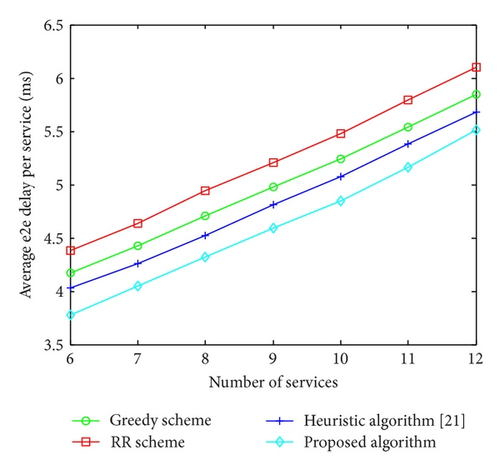
Figure 3 presents the delay performance with respect to the average packet arrival rate for the four scheduling schemes. In the simulation, there are 6 types of services supported and αk = 0.8 for each service. The average packet arrival rate for all services is set from 1 to 7 in order to prevent buffer overflow. From the figure, we can see that the average e2e delay per service in the proposed scheduling algorithm is smaller than the other schemes no matter how much the packet arrival rate is. In addition, the average delay value increases quickly with the increase of average packet arrival rate, which can be explained by Little’s law. For the video services on the train, the average packet arrival rate is very high, so it is necessary to provide a large buffer or improve wireless transmission rate so as to prevent buffer overflow.
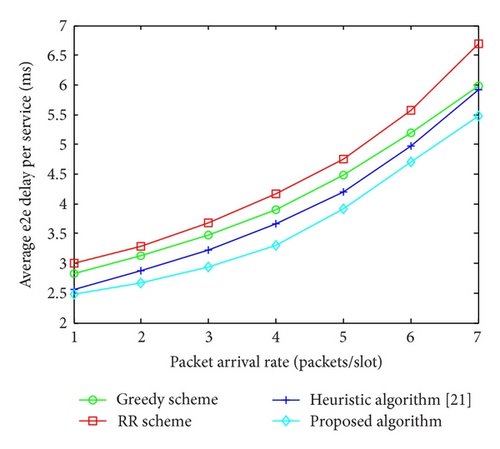
Figure 4 indicates the service delivery performance under the four scheduling schemes with K = 6 service types. The average packet arrival rates for all services are equal to 6 packets/slot. Based on the delivery ratio constraints (9), we define the satisfaction parameter εk of service k as the ratio of average throughput to αkλk; that is, . A larger εk represents the higher satisfaction of service k and εk ≥ 1 implies that the delivery ratio constraint for service k is satisfied. Let the delivery ratio requirements from service 1 to service K be 0.9, 0.9, 0.8, 0.8, 0.7, and 0.7. For service k, the rightmost bar shows the parameter εk for the proposed scheduling algorithm, and the remaining bars represent the parameter εk for the other three schemes. Simulation results show that the proposed distributed two-stage scheduling algorithm can achieve better service delivery performance over other schemes. This can be explained as follows. The RR scheme is fair in terms of scheduling opportunities but not channel/queue aware, the greedy scheme schedules the service with more packets in its buffer but does not consider the channel condition, and the heuristic scheduling algorithm is developed based on transmission rate, packet utility, and proportional fairness, which does not consider the heterogeneous delivery ratio requirements for different services. The same is true for both the two stages. Thus, the proposed algorithm, which is channel/queue aware and considers the service delivery ratio requirements, will be efficient on delivery ratio constraints in the long term.
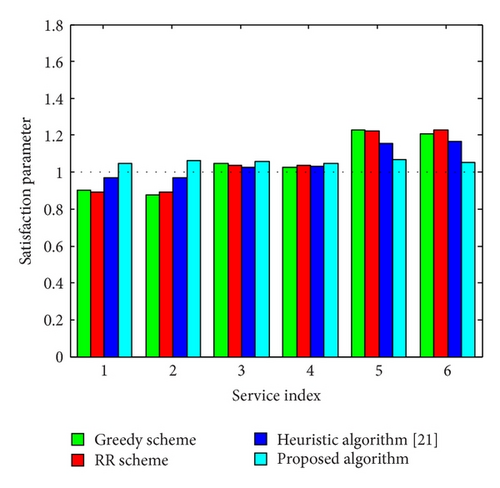
Figure 5 illustrates the convergence property of the proposed distributed online scheduling algorithm. We plot the value functions of the CS for the first type of service versus scheduling slot index. It can be seen that the distributed algorithm converges quite fast and the values are extremely close to the final converged results after 200 iterations. The similar results can be obtained for per-node value functions at other CSs and RS. By comparing different curves, we can see that the per-node value function is increasing in queue backlog q. There are two reasons to explain this property. First, the value of per-slot cost function (7) grow linearly with the increase of queue backlog q. Second, the value function is positively correlated with the per-slot cost function based on (15). Furthermore, unlike the iterations in static optimization problems, the proposed scheduling algorithm is online, implying that data packets are delivered during the iteration steps.
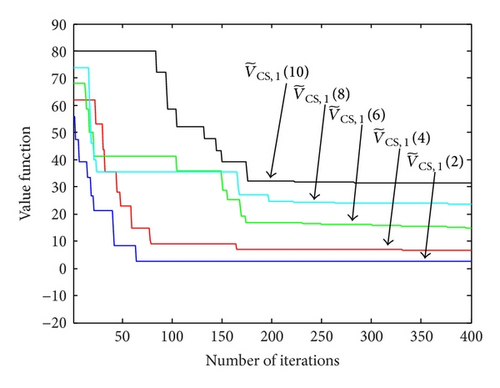
6. Conclusion
Providing passengers with multimedia services is one of the most important applications in HSR communication systems. This paper investigated delay-aware downlink service scheduling problem with stochastic packet arrivals and QoS requirements in relay-assisted HSR communication systems. We elaborate on the theory of MDP and illustrate how the approximate MDP and stochastic learning could help in obtaining low-complexity and distributed scheduling solutions. Simulation results show that the proposed algorithm outperforms other existing schemes in terms of average e2e delay and service delivery performances. Furthermore, the convergence of the proposed distributed online scheduling algorithm is shown by simulations.
For our future work, we will investigate the dynamic stochastic scheduling problem in the HSR networks using the stochastic network optimization approach. In addition, since the delay-aware is considered, motivated by [23], the design of a dynamic output feedback controller is necessary for multimedia services transmission in HSR communication systems.
Conflict of Interests
The authors declare that there is no conflict of interests regarding the publication of this paper.
Acknowledgments
This work is supported by the Fundamental Research Funds for the Central Universities (Grant no. 2014YJS026), the Key Projects of State Key Lab of Rail Traffic Control and Safety (nos. RCS2012ZZ004 and RCS2010ZT011), the China Postdoctoral Science Foundation (Grant no. 2013M530519), and the Natural Science Foundation of China (Grant no. U1334202).




